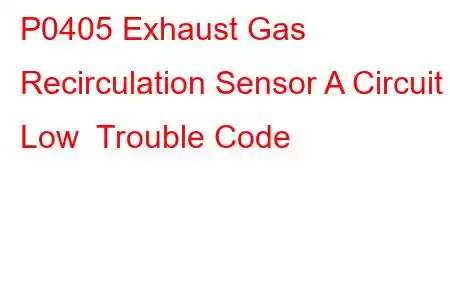P0405 EGR Sensor A Circuit Low
OBD-II Trouble Code Technical Description
Exhaust Gas Recirculation Sensor A Circuit Low
What does that mean?
This diagnostic trouble code (DTC) is a generic powertrain code, which means that it applies to OBD-II equipped vehicles. Although generic, the specific repair steps may vary depending on make/model.
There are different designs of EGR (Exhaust Gas Recirculation) systems, but they all operate in a similar way. The EGR valve is a PCM (Powertrain Control Module) controlled valve that allows measured amounts of exhaust gasses to pass back into the cylinders to be burned with the air/fuel mixture. Since exhaust gas is an inert gas that displaces oxygen, injecting it back into the cylinder can lower combustion temperatures which helps to improve NOx (oxides of nitrogen) emissions.
EGR isn't needed on cold startup or at idle. EGR is commanded on under certain conditions like startup or at idle. EGR is commanded on under certain conditions like partial throttle or decel depending on engine temperature and load, etc. Exhaust gasses are supplied to the EGR valve from an exhaust pipe or the EGR valve may be mounted directly in the exhaust manifold. When needed, the valve is commanded "on" allowing the gasses to pass into the cylinders. Some systems divert exhaust gasses directly into the cylinders while others simply inject it into the intake manifold where it is then pulled into the cylinders. while others simply inject it into the intake manifold where it is then pulled into the cylinders.
Some EGR systems are quite simple while others are a little more complicated. Electrically controlled EGR valves are directly controlled by the PCM. A wiring harness plugs into the valve itself and is commanded by the PCM as it sees the need. These can be 4 or 5 wire. Usually 1 or 2 grounds 12 volt ignition feed, a 5 volt reference circuit, and a feedback circuit. Other systems are vacuum controlled. These are quite simple. The PCM controls a vacuum solenoid which when activated, allows vacuum to travel to the EGR valve and open it. There should also be an electrical connector on this type of EGR valve for the feedback circuit. The EGR system feedback circuit allows the PCM to see if the EGR valve pintle is actually moving as it should. If the feedback circuit detects that the voltage is unusually low, or it's position is lower than it's commanded to be, P0405 may set.
Symptoms
Symptoms of a P0405 DTC may include:
MIL (Malfunction Indicator Lamp) illuminationCauses
Potential causes of a P0405 code include:
Short to ground in EGR signal or Reference circuits Short to voltage in EGR ground or signal circuits Bad EGR valve Bad PCM wiring issues due to chafing or loose terminalsPossible Solutions
If you have access to a scan tool you can command the EGR valve on. If it responds and the feedback indicates the valve is moving properly then the problem may be intermittent. Sometimes in cold weather, moisture can freeze in the valve causing it to stick. After the vehicle warms up the problem may disappear. Carbon or other debris can lodge in a valve causing it to stick also
If the EGR valve doesn't respond to your commands with the scan tool, disconnect the EGR harness connector. Turn the key to on position, engine off (KOEO). Using a voltmeter, check for 5 volts on the reference wire to the EGR valve. If there is no 5 volts, is there any voltage at all? If there is 12 volts, then repair short to voltage in the 5 volt reference circuit. If there is no voltage connect a test light to battery voltage and probe the 5 volt reference wire. If the test light illuminates, the 5 volt reference circuit is shorted to ground. Repair as necessary. If the test light doesn't illuminate check for an open in the 5 volt reference circuit. Repair as necessary
If there is no apparent prob
Read: 38


